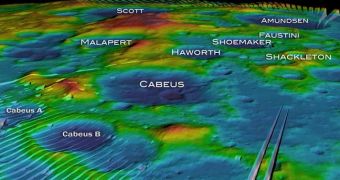Tomorrow, at 7:31 am EDT (1131 GMT), skywatchers and professional astronomers will be able to see for the first time how a spacecraft plunges to its fiery demise, as it slams into the Cabeus crater, at the Moon's south pole. According to the American space agency, a spent Centaurus rocket stage, attached to the Lunar CRater Observation Sensing Satellite (LCROSS) spacecraft, will hit the lunar surface first, followed, a few minutes later, at around 7:35 am EDT (1135 GMT), by the satellite itself. The probe will fly with all its instruments activated and pass straight through the plume of ash that the Centaurus stage will create, Space reports.
Experts at NASA hope that the 5,216-pound (2,366-kilogram) rocket stage, which will impact Cabeus while traveling at about 5,600 miles per hour (9,010 kilometers per hour), will lift about 385 tonnes of soil – and, hopefully, water-ice – from the bottom of the crater. The Sun hasn't shone in the area for thousands, if not millions, of years, so there are high hopes that the location still preserves its waters, if it has ever had any. The collision of the 42-foot (13-meter) Centaurus will be broadcast on NASA TV, beginning at 6:30 am EDT (1030 GMT).
“From west of the Mississippi all the way out to Hawaii is in prime viewing conditions. You only need a ten to 12-inch telescope. So it's a really good opportunity for a lot of people to be involved. We're asking anyone who observes the impact to upload their data to us. This may be the largest event that's been observed for a NASA mission in recent memory,” Jennifer Heldmann, an expert at the NASA Ames Research Center, in Moffett Field, California, says. She is also the LCROSS Observation Campaign lead investigator.
“Whatever answer we get back, if we see ice or we don't, is going to be significant. So either it's not there, or there's some patchiness and spottiness to it, if it is indeed there. We're going to learn a lot no matter what results are obtained. It has been a lot of work for four minutes of data, but it's a really important four minutes of data. Hopefully, we'll have a variety of data sets that we can combine and make a coherent story. That's the going-in plan,” she adds.
Tomorrow will mark a historic moment. Actually detecting water-ice could have considerable implications for space exploration and for our future among the stars. The method used for the investigation is quite simple. As Centaurus will slam into the ground, it will generate a massive column of debris, which will appear between the Sun and the Earth. Telescopes and spectrometers will then analyze the plume, and determine whether the soil contains traces of water or not. Additionally, as LCROSS will head for its own doom, it will pass through the plume, conducting scientific measurements and relaying them in real time back to the Mission Control until it crashes.

 14 DAY TRIAL //
14 DAY TRIAL //